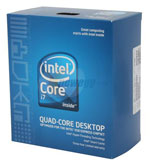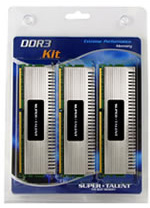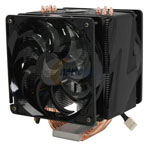Intel Performance Midrange
In recent months, AMD is finally effectively competing in midrange computer systems. With the AMD Phenom II line, Intel and AMD enjoy rough parity in the price ranges and processor speeds where they compete. Of course, the top AMD still cannot compete with Intel Core i7, which remains the performance leader. We could have chosen an Intel CPU for our performance midrange that would have competed very well with the AMD Phenom II 955BE used in the AMD performance midrange setup. The problem with that is we would not make that choice ourselves. If we were spending $1600 or more a system, we would definitely stretch the extra $150 to buy a Core i7-920 system. That is exactly what we did for the Intel performance midrange system. (You can of course trim down other component choices to get into a Core i7 system for less money, but we're going with the type of system we would like to build.)
The reasoning was very simple. It was difficult to recommend another Intel system at anywhere close to the price point of the i7-920, and socket 1366 components have been dropping in price over the past three months. For those reasons if you plan to spend over $1000 on a base Intel box you should definitely consider a Core i7-920 system. That will likely change with the coming i5 release providing additional Intel midrange choices.
| Intel Performance Midrange PC | ||
| Hardware | Component | Price |
| Processor | Intel i7 920 Nehalem Socket 1366 (2.66GHzx4 4x256MB L2, 8MB L3 Cache) | $280 |
| Cooling | Vigor Monsoon III LT for Socket 1366 | $55 |
| Motherboard | GIGABYTE GA-EX58-UD3R LGA 1366 Intel X58 ATX (after $15 rebate) | $180 |
| Video | MSI Radeon HD 4890 1GB OC Edition (After $30 Rebate) | $170 |
| Memory | Super Talent Chrome 6GB DDR3-1600 Triple Channel Kit WB160UX6G8 8-8-8-18 | $96 |
| Hard Drive | Western Digital Caviar Black 1TB WD1001FALS | $95 |
| Optical Drive | LG BD/HD DVD 8X BD read/16x DVD read/write CH08LS10 - Retail | $130 |
| Audio | On-Board | $ - |
| Case | Cooler Master Storm Scout SGC-2000-KKN1-GP Mid-Tower | $100 |
| Power Supply | Corsair CMPSU-750TX 750w 80 PLUS Certified SLI/Crossfire Ready Core i7 Power (after $20 Rebate) | $100 |
| Base System Total | $1206 | |
| Display | ASUS VW266H Black 25.5" 2ms(GTG) HDMI Widescreen LCD Monitor (1920x1200) (after $30 Rebate) | $300 |
| Speakers | Logitech G51 155 watts RMS 5.1 Surround Sound Speakers - Retail | $120 |
| Input | Microsoft CA9-00001 Black PS/2 Standard Keyboard and Optical USB/PS2 Mouse - OEM | $16 |
| Operating System | Microsoft Vista Home Premium OEM | $99 |
| Complete System Bottom Line | $1741 | |
| SSD (Optional) | OCZ Vertex OCZSSD2-1VTX120G 2.5" 120GB SATA II MLC Internal Solid State Disk | $339 |
 |
The i7-920 is the lowest priced Intel Core i7 you can currently buy. The other choices, even after the recent i7-975 and i7-950 introductions, are in the $562 to $1000 range. Don't assume, however, that the 920 isn't a powerful processor. The i7-920 is capable of reaching the performance levels of the top i7 CPUs, because it has also proven to be a dynamite overclocker for those who care about that - provided they are also willing to provide decent cooling to the i7-920.
The Core i7-920 is 30% faster in some parameters than a Core 2, and you can overclock this 2.66GHz CPU to 3.8GHz to 4GHz with careful tweaking and better cooling. As shown in the Phenom II launch, the 920 reached as high as 3.8GHz at stock voltage and 4.0GHz when overvolted to 1.35V. That is a 50% overclock without a ton of effort on air-cooling. You will certainly be very happy with Core i7 base performance, but if you are interested in overclocking you will be extremely pleased with this CPU.
 |
The GIGABYTE GA-EX58-UD3R remains the X58 board of choice for the Core i7-920. It is one of the least expensive X58 chipset motherboards currently available. Others have joined that +/-$200 X58 club in recent months, but the GIGABYTE still provides excellent value and is now selling with a rebate that reduces the price to $180. Test results and user reports for the GIGABYTE EX58-UD3R are very favorable. This low-priced X58 board also excels in overclocking, which is why it remained the motherboard choice for the performance midrange Intel system. Other good choices are the MSI X58 Pro LGA 1366 and the ASRock X58 Deluxe LGA 1366.
 |
Super Talent introduced an excellent 6GB triple-channel memory kit in their Chrome DDR3-1600. This Super Talent 6GB kit is another low-voltage memory kit preferred in AnandTech memory testing. Specifications are 8-8-8-18 timings at DDR3-1600 and 1.65V. This triple-channel memory kit provides excellent value in a 6GB kit and overclocking headroom to spare with its low voltage design. Six months ago in our last midrange guide, a slower 6GB kit set you back $145 where the Super Talent DDR3-1600 is now $96. DDR3 prices just continue to drop. You can select from a number of quality memory suppliers, but make sure to include their warranty and customer service reputation in your decision-making.
 |
Unfortunately, the Core i7 CPU runs hot and eats lots of power. In fact, the stock Intel HSF is barely adequate for the CPU, which is a change in philosophy from lower Intel processors. For those reasons we almost always recommend a third party CPU cooler for an i7 system - particularly if you plan to overclock at all. Our cooler choice to mate with the GIGABYTE X58 board is the Vigor Monsoon III LT at $55. This Monsoon is a standard vertical heatpipe air-cooler, with effective and quiet push-pull cooling. The Monsoon appears a good match to the OC capabilities of the i7-920. Another excellent option is the Thermalright Ultra 120 eXtreme with the 1366 mounting kit. You pay a bit more for the Thermalright cooler, but this top Core 2 cooler also works very well when paired with a Core i7.










71 Comments
View All Comments
Black Jacque - Monday, July 27, 2009 - link
>For instance there are hardly any quality power supplies in the 450->550W range that offer 2 6-pin PCIe connectors (a requirement to run >HD 4870/90 and GTX 260/275 cards).Like the Seasonic S12II-430 Bronze (1xPCIe-6, 1xPCIe-6+2)?
In addition, most GPUs come with a Power Cable to adapt the standard Molex to PCIe-6. The recommended MSI HD 4890 comes with two Power Cables.
> it makes good long term sense to throw in another $25 and get a >more powerful PS for your future upgrade needs.
The Xbit Labs article clearly states the trend in PC parts power consumption is downward, not upward. Besides, I'd rather not spend US$25 that I didn't have to. I could use that money to upgrade to a Q9400 or an E8500, something I could use rightaway.
Nfarce - Monday, July 27, 2009 - link
"Like the Seasonic S12II-430 Bronze (1xPCIe-6, 1xPCIe-6+2)? "Not real familiar with that brand. Try finding one in the range I mentioned built by Antec, Corsair, OCZ, Thermaltake, or PC Power & Cooling. And 430W? I have that in a five year old P4 system. I don't think so. I'll spend the extra few clams on something future proof, and apparently others agree. If you have to worry about spending another $25 on an $850+ PC build, then maybe you need to reconsider your spending priorities.
Black Jacque - Monday, July 27, 2009 - link
>Not real familiar with that brand. Try finding one in the range I >mentioned built by Antec, Corsair, OCZ, Thermaltake, or PC Power & >Cooling.Seasonic can be found providing OEM service on various model lines for: Antec, Corsair, PC Power and Cooling, and of course under their own Seasonic brand. Actually, the PSUs that Seasonic either designs or builds for Antec, Corsair or the old PCP&P are not as high quality as the PSUs they build under their own brand label.
Nfarce - Tuesday, July 28, 2009 - link
Thanks for the info Black Jacque. I did not know that, and I now verified that fact. Of all the PS research I did prior to my build, no reviews mentioned that fact. However, I will still stand by spending a little more on a future proof power supply so as one less thing to have to upgrade. My Corsair 750W will take me into next year's planned Lynnfield build and the new DX11 cards with SLI (hopefully).haplo602 - Monday, July 27, 2009 - link
the article is one from the "how much power do we need" round that almost every major hardware review site did.however it was more or less questioning the need of 700+ W PSUs for the normal systems (i.e. average home PC).
you have to account also for the usage pattern. this site is aimed at the hardware enthusiasts. they tend to buy informed or tend to change components often. in the first case, they will ignore the PSU recommendation, in the 2nd case, it comes in handy in the future.
also have a look at power consumption on overclocked components (f.e. CPUs increase quite dramaticaly with added voltage). IIRC the xbitlabs article did not take into account overclocking (I might be wrong, did not read into details there).
brybir - Monday, July 27, 2009 - link
You keep referring to that article and after raeding it I do find it interesting. But all it says is that usage is trending downword. That trend is based on events that have already happened and then assuming what future events will occur with power draw based off similar past events.First, just because the trend is in one direction does not mean that it is going to continue that way in the future. That is to say that the past predicts the future which is simply not true.
Second, it makes sense to me to spend $25 on a larger power supply than I need "right now" so that I do not have to worry about replacing the power supply later on. You can say that the general power draw will decrease over time but in each individual case that is not going to be necessarily true. I just went from a system with a 65W CPU and a ATI 4670 to a 125W CPU and a 4870 OC using the same power supply. Had I bought the power supply that exactly fit my previous system I would now have to buy a new power supply. So in my case buying a larger power supply has been a great idea and will save me from spending another $70 this time around. Who knows, since its a 550W supply maybe it will last me another three years.
Black Jacque - Monday, July 27, 2009 - link
>First, just because the trend is in one direction does not mean that >it is going to continue that way in the future. That is to say that >the past predicts the future which is simply not true.You are joking, right?
http://products.amd.com/en-us/DesktopCPUDetail.asp...">http://products.amd.com/en-us/DesktopCPUDetail.asp...
If you understand how the past can predict the future, its no surprise that AMD improved their process and shaved 30W off this part's (AMD Phenom™ II X4 945) power consumption after a bit more than 5-months of production. (BTW, this part costs US$1 more than its 125W sibling at ZZF.)
Looking into my crystal ball, I predict ~3 GHz 65W quad CPUs by either AMD or Intel within a year.
haplo602 - Monday, July 27, 2009 - link
each system has at least a 2x PCIex16 board, so the higher watt PSU is an "insurance" for future upgrades.anyway the builds are unbalanced in my view. they get away with far too cheap displays.
my current planed build is 1:1 in components vs lcd cost. My total component cost is about 600 euro, the display will cost me around 500 euro :-)
but I am more looking at photo editing than gaming.
Black Jacque - Monday, July 27, 2009 - link
>so the higher watt PSU is an "insurance" for future upgrades."The recent, excellent Xbit Labs article "PC Power Consumption: How Many Watts Do We Need?" clearly illustrates that 750W PSUs are a waste of money in the mid-range when not going with SLI or Crossfire. This article shows the trend in PC parts is downward in power consumption."
I can't even accept the idea of adding a second GPU later when they get less expensive. The general trend is the next generation of GPU outperforms the previous generation in Crossfire or SLI at a lower price.
erple2 - Monday, July 27, 2009 - link
I suppose that's true. However, it's also true that the next generation of GPU also tends to consume more power than the previous generation. Normally, not 2x the power, but 20-50% more power isn't unheard of.Though, you're right. Buying a power supply strictly because it makes the PSU itself a little bit more future proof doesn't necessarily make that much sense. How often does the midrange buyer upgrade their systems? Every 2 years? 3 years? What's the reasonable lifetime of a PSU? 3 years? 5 years? Is it enough to last through a full upgrade cycle? If the answer is "yes", then it's certainly possible that buying a slightly higher end power supply can be worth it. You pay the extra 25 dollars now, but save 75 dollars for the next upgrade.
Unless the next generation of chips use less power than the current gen, which I don't think is going to be the case (the only exception that I can think of in the x86 world was the move from Pentium 4 to Core2Duo), then buying a slightly larger power supply than necessary isn't necessarily a bad idea. Now, going with 750 Watts with a non-SLI, non-XFire setup does seem a bit silly.
If you overclock, I don't know how that impacts the power consumption of the system, either. Maybe a study on that would be interesting?